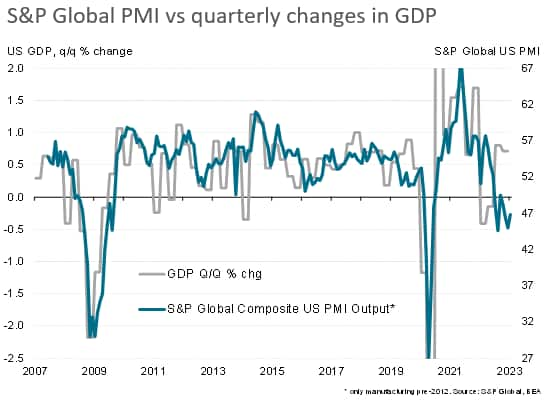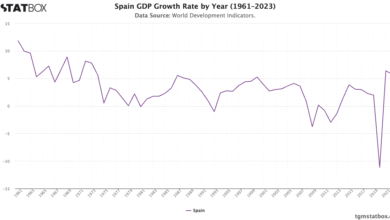US Economy Contraction: Understanding the Latest GDP Decline

The recent contraction of the U.S. economy has raised alarm bells among economists and policymakers, as the GDP declined by 0.3% in the first quarter of 2025. This downturn has been largely attributed to a surge in imports spurred by the uncertainties surrounding Trump tariffs, which created a rush for businesses to stock up on goods before potential price hikes. As the first negative growth reported since Q1 of 2022 unfolds, concerns about inflation impact add a layer of complexity to the situation. Despite a previous robust growth of 2.4% in the fourth quarter of 2024, the latest report underscores how quickly economic growth can wane when external pressures mount. Market projections had anticipated a rebound, highlighting the stark contrasts between expectations and the stark reality reflected in these first quarter results.
The latest economic data highlights a troubling reversal for the United States, with alarming indicators suggesting a slip into negative territory. The recent figures reveal a contraction in the overall economic output, which many analysts view as a troubling signpost during a critical period marked by trade tensions and tariff implementations. This downturn is particularly significant given the backdrop of previous growth trends, leaving economists puzzled about the sustainability of economic vigor moving forward. With key factors such as a brisk increase in imports and a slowdown in consumer spending coming into play, the trajectory of the nation’s economic climate appears increasingly precarious. The looming question is whether these recent developments signal a temporary blip or a more entrenched trend in the face of ongoing tariff disputes and inflationary pressures.
Impact of U.S. Economy Contraction on Future Growth
The recent contraction of 0.3% in the U.S. economy during the first quarter of 2025 has raised significant concerns about the trajectory of future economic growth. With GDP decline as a prominent theme, economists are closely monitoring how ongoing trade tensions may further influence market conditions. The surge in imports, occurring ahead of the anticipated Trump tariffs, suggests businesses and consumers are adjusting their strategies in an uncertain environment. This adjustment, while seeming to negatively impact the GDP now, might potentially lay a foundation for recovery as businesses adapt and find new avenues for growth.
Moreover, there’s a silver lining in these macroeconomic shifts as the contraction may not reflect a fear-fueled downturn but rather a recalibration of economic activities before tariff implementations. The possibility of reversing this trend in subsequent quarters provides a glimmer of hope for economic recovery. Should consumer spending increase, alongside stabilizing import levels, the foundations for future economic growth could be fortified, thereby offsetting fears stemming from the contraction.
Evaluating the Effects of Trump Tariffs on Imports and Exports
The implementation of Trump tariffs has undeniably influenced the economic landscape, particularly evident in the dramatic increase of imports by 41.3% in early 2025. This spike, largely driven by businesses rushing to stock up on goods before the tariffs took effect, resulted in a negative impact on the GDP as these imports effectively subtract from the overall economic output. However, this behavior may be interpreted not only as a reaction to tariffs but also as an indication of businesses striving to benefit from competitive pricing and avoid future cost hikes.
On the flip side, exports experienced a modest rise of 1.8%, reflecting a persistent demand for U.S. goods despite the global uncertainties. The contrasting trends in imports and exports suggest a nuanced landscape where immediate tariff implications come into play, yet they also hint at the potential for innovation and adaptation within U.S. industries. As businesses navigate these challenges, focus on developing competitive advantages could mitigate some of the negative impacts of the tariffs.
The Influence of Inflation on Federal Reserve Decisions
With inflationary pressures intensifying, as evidenced by a 3.6% increase in the personal consumption expenditures price index in the first quarter of 2025, the Federal Reserve may face a difficult decision-making landscape. The dual challenge of navigating negative GDP growth alongside rising inflation complicates policy responses. Traditionally, high inflation would prompt interest rate hikes to cool spending; however, current contraction figures underscore the need for stimulating growth, potentially leading to a delicate balancing act for policymakers.
As the Fed approaches its next policy meeting, the pressure to respond to economic signals intensifies. The insistence on careful monitoring of both inflation rates and economic growth indicators suggests that strategies may evolve based on the data trends observed in recent months. The intertwined relationship between inflation impact and consumer spending will play a crucial role in shaping any monetary policy adjustments made by the Fed.
Consumer Spending: A Bright Spot Amidst Economic Contraction
Despite the overall U.S. economy’s contraction, consumer spending increased by 1.8%. This positive development signals resilience in key areas, even amidst broader economic challenges. Slowdowns in spending growth are concerning but not alarming, as they can often be attributed to seasonal fluctuations and prior peaks in activity during holiday seasons. The sustainability of this spending trend holds immense importance for future economic stability as consumer behavior directly influences overall economic health.
The discrepancy between consumer spending growth and GDP contraction highlights a critical aspect of the economy; while the aggregate numbers may appear grim, internal factors like consumer confidence and spending patterns reveal more nuanced insights. As long as personal consumption remains stable, it could buffer the effects of contraction, offering a potential pathway for economic recovery in upcoming quarters.
Trade War Concerns and Economic Predictions
The ongoing trade war instigated by tariffs during Trump’s administration has incited a climate of uncertainty, influencing both economic predictions and business decisions. Experts now examine how these policies might shape long-term economic landscapes as they can lead to restructuring in supply chains and trade relationships. The unpredictable nature of trade negotiations will likely continue to cast a shadow over economic generational trends unless resolved effectively.
As businesses recalibrate to the ever-shifting trade landscape, forecasting remains a challenge. The contraction observed suggests that the immediate impact of tariffs on the economy is palpable, leading to hesitance in investment decisions and spending. However, economists remain cautiously optimistic, indicating that positive adjustments might emerge if businesses begin transitioning toward greater domestic sourcing and innovation in their operational frameworks.
Quarterly Analysis: First Quarter Economic Results
Looking closer at the first quarter results of 2025 reveals critical insights into the underlying economic conditions amidst global fluctuations. The unexpected shift from a projected gain of 0.4% to an actual decline of 0.3% in GDP was influenced, in part, by the surprising rise in imports leading up to tariff enactments. While economic treaties and international relations continue to evolve, such abrupt shifts can cause ripples that influence consumer confidence and fluctuate market sentiments.
This quarterly report, representing the first instance of negative GDP growth since Q1 of 2022, may spark renewed discussions regarding economic policy adaptability under Trump’s administration. Stakeholders in various sectors are now tasked with ensuring they adjust their strategies in response to fluctuating economic signals and prepare adequately for future quarters, where economic recovery could hinge upon market resilience and strategic foresight.
Economic Growth Predictions Amid Government Intervention
Government intervention through tariffs and trade negotiations plays a significant role in shaping economic growth trajectories. Trump’s policy decisions are currently under scrutiny as businesses react to economic conditions head-on. With many companies adjusting their strategies to avoid tariffs, experts wonder if such governmental policies might ultimately lead to slower economic recovery or innovative shifts toward bolstering domestic industries.
Long-standing relationship dynamics between trade policy and economic growth cannot be overlooked. As businesses adapt to tariffs and market fluctuations, sectors that can innovate in response to governmental changes may thrive, potentially leading the economy toward a growth turnaround. Overall assessments will evolve as policymakers respond dynamically to domestic and international economic developments.
Navigating Economic Uncertainty: Consumer Confidence
The contraction in the U.S. economy has understandably affected consumer confidence, an essential driver of economic stability and growth. Consumers often exhibit caution during uncertain times, which can result in decreased spending and impacts on business revenues. As personal consumption expenditures rise, albeit slowly, a deeper dive into what drives consumer confidence is warranted to ensure sustained growth post-tariff era.
Widespread perceptions of economic performance, driven by political implications and macroeconomic indicators, shape how consumers approach spending decisions. Policymakers and economists alike must pay attention to sentiment as they navigate proposed fiscal strategies that could reinvigorate consumer confidence and spur economic growth amidst challenging conditions.
Future Trends: Recovery Post-Contraction
As the economy contracts, discussions around future recovery trends increasingly gain prominence. History indicates that after periods of negative growth, economies often rebound, fueled by pent-up demand and strategic business adjustments. The current economic landscape, influenced heavily by tariff policies and trade dynamics, provides a unique case study for assessing recovery trajectories in subsequent quarters.
Observing how consumer spending, investment, and fiscal policy evolve post-contraction will be critical in predicting the pace and sustainability of economic recovery. If businesses can effectively leverage innovations and adapt their strategies in response to the current climate, the potential for a robust recovery could be realized, addressing fears of prolonged economic stagnation.
Frequently Asked Questions
What are the primary causes of the recent U.S. economy contraction in 2025?
The U.S. economy contraction in 2025, marked by a 0.3% GDP decline, was primarily driven by a significant surge in imports as businesses rushed to bring in goods before the implementation of Trump tariffs. The 41.3% increase in imports, particularly a 50.9% rise in goods, negatively impacted GDP calculations, contributing to the decline in economic growth.
How do Trump tariffs relate to the U.S. economy contraction observed in the first quarter of 2025?
Trump tariffs played a crucial role in the U.S. economy contraction of 0.3% in Q1 2025, as businesses accelerated imports to avoid anticipated price increases. This surge in imports, while boosting supply temporarily, ultimately detracted from GDP, illustrating the immediate economic effects of tariff policies.
What impact does inflation have on the current state of U.S. economy contraction?
Inflation has significant implications for the U.S. economy contraction, as indicated by a 3.6% increase in the personal consumption expenditures price index during the first quarter of 2025. While inflation pressures could influence Federal Reserve policies, the negative GDP growth reflects a complex environment where rising costs are counteracting economic expansion.
What were the first quarter results indicating about U.S. economic growth and contraction trends?
The first quarter results for 2025 revealed a contraction in the U.S. economy, with a 0.3% GDP decline. This marked the first negative growth since Q1 2022, suggesting potential shifts in economic trends amid policy changes and external pressures like tariffs, which increased import activity and affected overall economic performance.
What are the potential long-term effects of the U.S. economy contraction on consumers and businesses?
The U.S. economy contraction may lead to cautious consumer spending and investment patterns in the near future. Businesses might adjust strategies to cope with tariff uncertainties and inflation impacts, potentially resulting in slowed economic growth if consumer confidence does not rebound.
How did economists predict the U.S. economy contraction prior to the first quarter 2025 results?
Before the first quarter 2025 results, economists had forecasted a 0.4% growth in GDP. However, as the data showed substantial import increases due to Trump tariffs, many revised their expectations to anticipate the contraction, highlighting the importance of trade policies in economic forecasting.
Can the U.S. economy recover from this contraction in subsequent quarters?
Yes, the U.S. economy can potentially recover from this contraction in subsequent quarters. The surge in imports suggests an inventory buildup that could lead to increased economic activity as businesses adjust to tariff impacts and consumer demand picks up, provided inflation remains manageable.
What should the Federal Reserve consider in response to the U.S. economy contraction?
In response to the U.S. economy contraction, the Federal Reserve should consider the balance between lowering interest rates to stimulate growth and addressing inflation concerns, given the significant increases in the personal consumption expenditures price index during the same period.
| Key Point | Details |
|---|---|
| Economic Contraction | U.S. economy shrank 0.3% in Q1 of 2025, the first negative growth since Q1 of 2022. |
| Reasons for Contraction | Surge in imports (up 41.3%) ahead of tariffs which negatively impacted GDP calculations. |
| Consumer Spending | Personal consumption increased by 1.8%, the slowest growth since Q2 of 2023. |
| Private Domestic Investment | Risen by 21.9%, driven by equipment spending that may have been influenced by tariff anticipation. |
| Federal Reserve Response | Negative growth may trigger interest rate cuts, but rising inflation concerns could complicate decisions. |
| Market Reaction | Stock market futures dropped and Treasury yields rose following the report. |
Summary
The recent contraction of the U.S. economy, which saw a 0.3% shrinkage in the first quarter of 2025, raises significant concerns about the overall economic health and the impact of President Trump’s trade policies. This slowdown is attributed primarily to a surge in imports as businesses rushed to avoid anticipated tariffs, which resulted in negative GDP growth. Despite positive contributions from consumer spending and private domestic investment, the mixed signals presented by the data complicate forecasts for the Fed and the market as a whole. As the nation braces for the repercussions of these economic shifts, it remains crucial to monitor future trends and potential recovery strategies.



